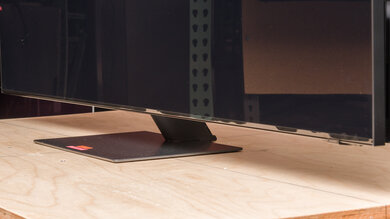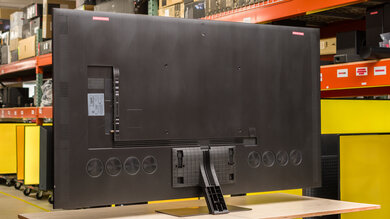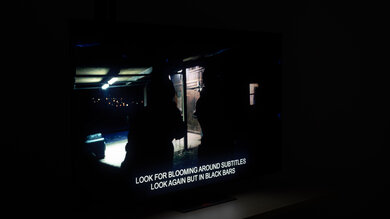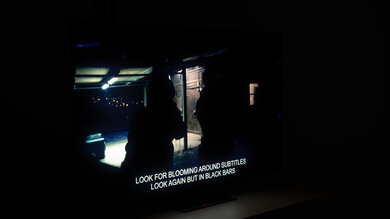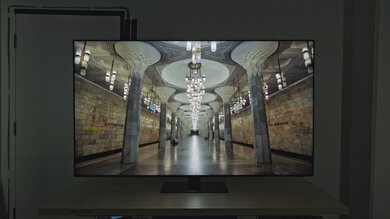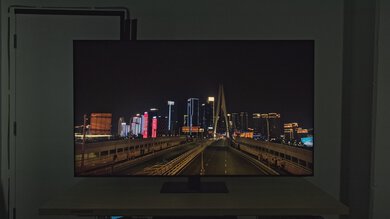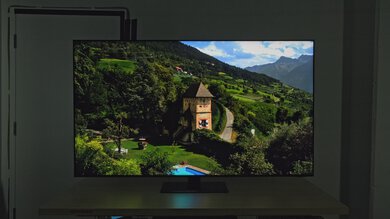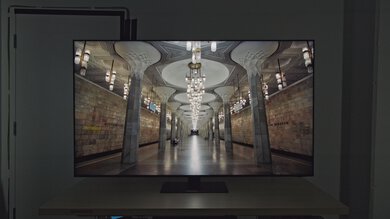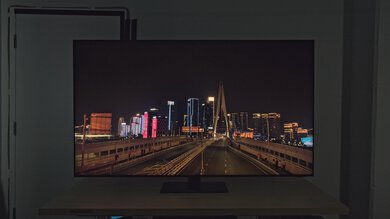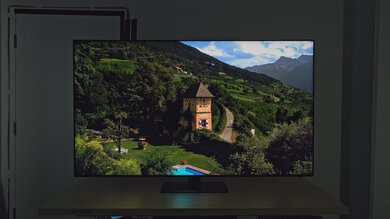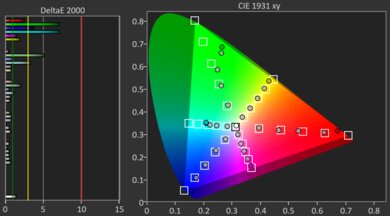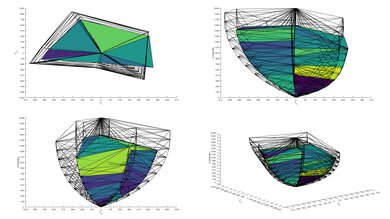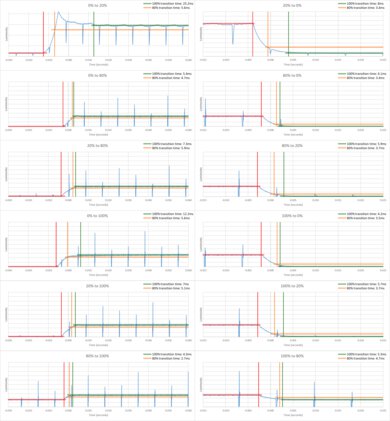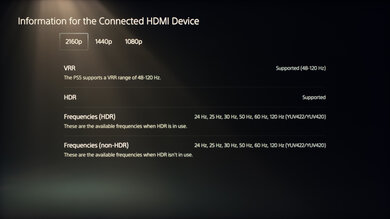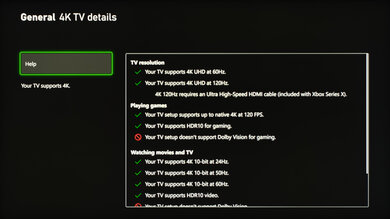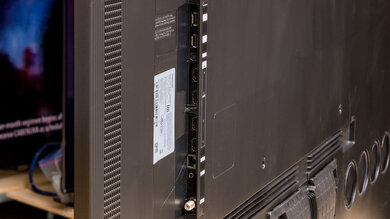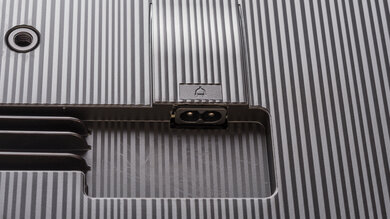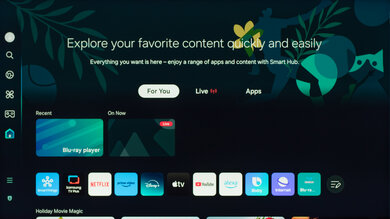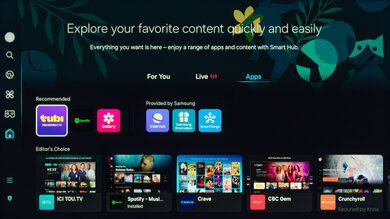The Samsung QN95D is a high-end 4k TV released in 2024. Like its predecessor, the Samsung QN95C QLED, the higher-end QN95D has nearly twice the number of dimming zones as the step-down model Samsung QN90D/QN90DD QLED. It's powered by Samsung's NQ4 AI Gen2 Processor and is advertised by Samsung to deliver better upscaling and sound processing. Like all Samsung TVs, it runs Samsung's proprietary Tizen OS interface, which offers a large selection of apps and games. It's compatible with the Bixby and Alexa voice assistants, supports Auto HDR remastering, and has Samsung's minimalistic Infinity One Design. We bought and tested the 65-inch model, but it's also available 75 and 85-inch sizes. Outside of North America, it's available in a 55-inch model as well.
Our Verdict
The Samsung QN95D is a versatile TV that excels in any setting or viewing condition. It’s perfect for daytime viewing in bright rooms, with superb brightness and incredible reflection helping to eliminate glare. For movie nights in dark rooms, its high contrast ratio and Mini LED local dimming deliver stunning levels of immersion. HDR content looks fantastic, with a wide color gamut and bright highlights that pop even in well-lit scenes. Additionally, it’s a top-notch choice for gaming, featuring low input lag, fast response times, and advanced gaming features like a 144Hz refresh rate and VRR support.
Superb SDR brightness so glare isn't an issue.
Easy-to-use smart interface with a great selection of apps.
Incredible reflection handling, so glare isn't an issue.
Poor pre-calibration accuracy in the TV's 'Warm 2' Color Temperature setting.
The Samsung QN95D is a great choice for watching TV shows during the day. Its superb SDR brightness and incredible reflection handling ensure mostly glare-free viewing, even in the brightest spaces. Its viewing angle is okay, although the image does noticeably degrade when viewed from the sides, it's still good enough for most people. The Tizen OS smart interface offers a wide range of streaming apps, and the built-in hands-free voice control lets you start watching your favorite shows effortlessly, even if the remote is misplaced.
Superb SDR brightness so glare isn't an issue.
Great low-resolution sharpness processing.
Easy-to-use smart interface with a great selection of apps.
Incredible reflection handling, so glare isn't an issue.
Poor pre-calibration accuracy in the TV's 'Warm 2' Color Temperature setting.
Just alright low-quality content smoothing.
Okay viewing angle, but not good enough for very wide seating positions.
The Samsung QN95D is a great TV for sports enthusiasts. Its fast response time in bright scenes ensures crisp and clear motion during fast-paced action. The TV's superb SDR brightness, combined with its incredible reflection handling, fights off glare very well, making it ideal for bright rooms. Its viewing angle is wide enough to let people watch from the sides without being overly annoyed by a degraded image. Finally, its good uniformity ensures that you won't be overly distracted by dark spots or an uneven image when watching sports with large areas of bright uniform colors.
Superb SDR brightness so glare isn't an issue.
Great low-resolution sharpness processing.
Easy-to-use smart interface with a great selection of apps.
Fast response time for clear motion.
Incredible reflection handling, so glare isn't an issue.
Okay viewing angle, but not good enough for very wide seating positions.
The Samsung QN95D is an excellent choice for gaming. Its incredibly low input lag delivers a smooth and responsive experience, and motion appears crisp and fluid thanks to its fast response time. It boasts an impressive array of gaming features, including 4k @ 144Hz support for cutting-edge PC graphics cards, VRR to minimize screen tearing, and full compatibility with next-gen consoles like the PS5 and Xbox Series X. It performs exceptionally well when you're gaming in a bright room during the day as it handles glare effortlessly in bright settings, especially with its incredible reflection handling.
Superb SDR brightness so glare isn't an issue.
Incredibly low input lag.
Great selection of gaming features including VRR and a 144Hz refresh rate.
Fast response time for clear motion.
Incredible reflection handling, so glare isn't an issue.
Slightly more blooming in Game Mode.
Poor pre-calibration accuracy in the TV's 'Warm 2' Color Temperature setting.
The Samsung QN95D offers an impressive movie-watching experience, especially in a completely dark room. Its exceptionally high contrast ratio and nearly perfect black uniformity make dark scenes look stunning, as bright highlights truly pop. HDR content shines with its fantastic HDR peak brightness and Mini LED local dimming, ensuring highlights are showcased as intended, even in bright scenes. With its wide color gamut, HDR movies appear vivid and lifelike. However, it lacks Dolby Vision HDR support, as Samsung prioritizes their own HDR10+ format, which delivers similar performance but isn’t as widely supported as Dolby Vision. The TV is also very inaccurate in the default 'Warm 2' Color Temperature setting, although you can greatly improve it through calibration.
Highlights in bright scenes stand out well.
Completely judder-free from all sources.
Easy-to-use smart interface with a great selection of apps.
Excellent PQ EOTF tracking.
Doesn't support Dolby Vision.
Doesn't support DTS audio formats.
Poor pre-calibration accuracy in the TV's 'Warm 2' Color Temperature setting.
Just alright low-quality content smoothing.
The Samsung QN95D provides an impressive HDR gaming experience. With its low input lag, fast response time, and extensive gaming features, it's already a top-tier choice for gamers, but HDR-supported games truly shine on this display. Its exceptional HDR brightness makes bright highlights in games pop, while the wide color gamut ensures vivid and vibrant colors. The fantastic contrast and superb dark-scene performance make it perfect for late-night gaming. Although the local dimming feature is slightly less effective in Game Mode, leading to a bit more blooming, the overall experience remains highly enjoyable.
Highlights in bright scenes stand out well.
Incredibly low input lag.
Great selection of gaming features including VRR and a 144Hz refresh rate.
Fast response time for clear motion.
Excellent PQ EOTF tracking.
Slightly more blooming in Game Mode.
The Samsung QN95D is an excellent choice for use as a PC monitor. It properly supports chroma 4:4:4 and RGB signals, ensuring sharp and clear text from a PC. With low input lag and a quick response time, desktop use feels smooth and responsive. Its okay viewing angle keeps the screen looking somewhat uniform, although the sides of the screen are dimmer than the center when sitting close. Additionally, its high SDR brightness and incredible reflection handling make it ideal for use in bright rooms without glare issues. However, it's only available in larger sizes, making it less suitable for smaller desks.
Incredibly low input lag.
Great selection of gaming features including VRR and a 144Hz refresh rate.
Fast response time for clear motion.
Incredible reflection handling, so glare isn't an issue.
Okay viewing angle, but not good enough for very wide seating positions.
Changelog
- Updated Jan 20, 2025:
We retested the TV's pre-calibration accuracy after purchasing a second unit and updated the score and text in that section.
- Updated Dec 18, 2024:
Samsung has informed us that our unit doesn't perform to their expectations and that the TV is out-of-spec. We've ordered a new unit from a different retailer, and we'll update the review with the new results as soon as possible.
- Updated Dec 13, 2024: Review published.
- Updated Dec 09, 2024: Early access published.
Check Price
Differences Between Sizes And Variants
We bought and tested the 65-inch Samsung QN95D, and these results are also valid for the 75-inch and 85-inch models. The 55-inch model isn't currently available in the U.S. but is widely available in other regions, and we expect it to perform about the same. There are currently no other variants of this TV available. Note that the last five letters in the model number (AFXZA in this case) vary between retailers and individual regions, but there's no difference in performance.
| Size | US Model | Short Model Code |
|---|---|---|
| 55" | - | QE55QN95D |
| 65" | QN65QN95DAFXZA | QN65QN95D |
| 75" | QN75QN95DAFXZA | QN75QN95D |
| 85" | QN85QN95DAFXZA | QN85QN95D |
Our unit was manufactured in August 2024, as indicated on the label.
Popular TV Comparisons
The Samsung QN95D is a great TV that delivers fantastic picture quality and has an impressive selection of additional features. It's a fantastic choice if you're looking to upgrade your home theater or living room setup, but it's pricey and doesn't really perform any better than the cheaper Samsung QN90D. One exception to that is in Game Mode, where the QN95D maintains its HDR brightness better than the QN90D does.
For more options, check out our recommendations for the best TVs, the best QLED TVs, and the best 4k gaming TVs.
The Samsung QN95D and the Samsung QN90D are almost identical, with only slight differences between them. The QN95D has slightly better contrast with local dimming enabled. The QN90D is inversely a tad brighter in HDR, although the QN95D maintains its brightness better in Game Mode. Additionally, the QN95D's HDR Native Gradient handling is much better than the QN90D's. Overall, you should get the cheapest one you can find.
The Sony BRAVIA 9 is better than the Samsung QN95D. The Samsung has very few advantages over the Sony, although it does have a slightly wider viewing angle and better HDR gradient handling. The Samsung also has four HDMI 2.1 ports, each capable of up to 4k @ 144Hz, while the Sony only has two HDMI 2.1 ports that are capped at 120Hz. Otherwise, the Sony is the better TV in basically every way.
The Sony BRAVIA 7 and the Samsung QN95D are closely matched. The Sony is more accurate out of the box than the Samsung and has better upscaling and low-quality content smoothing. While they're very similar when it comes to brightness, the Samsung does have vastly superior reflection handling, giving it the edge when watched in brighter rooms. Finally, the Samsung also has the edge for gamers with its four HDMI 2.1 ports, all capable of 4k @ 144Hz, while the Sony is limited to only two 120Hz HDMI 2.1 ports.
The Samsung QN95D and the Samsung QN95C are almost identical, and you should get the cheapest one you can find. The QN95D is a bit more colorful, but in turn, the QN95C is more accurate in the default 'Warm 2' Color Temperature setting.
Test Results

The Samsung QN95D has a very premium design, although it looks very similar to the Samsung QN95C QLED. Nevertheless, it has a modern and sleek look, and the bezels are incredibly thin.
The back of the TV looks great, with a nice textured design to the back panel. There are grooves along the back and through the stand to help with cable management and a cover that hides the cables on the stand for a really clean setup. There's also a connector near the top of the TV that allows you to connect a Samsung camera add-on, sold separately.
The Samsung QN95D has fantastic contrast, and the TV does a fantastic job displaying deep blacks even in complicated scenes with bright highlights.
Unfortunately, like the Samsung QN95C QLED, Samsung has removed the ability to fully disable the local dimming feature through the service menu. To calculate the native contrast ratio, we used this inverse contrast pattern. We took the average black levels of the four corners with the white area set to 200 cd/m².
The TV has decent lighting zone transitions. Unfortunately, the leading edge of bright highlights when they quickly move across the screen is visibly dimmer, and there's noticeable haloing.
The Samsung QN95D has fantastic HDR brightness. Highlights really pop out during darker scenes, and the TV is bright enough that very bright specular highlights even stand out in well-lit scenes. Combined with its fantastic contrast, this TV provides a very impactful HDR viewing experience.
Results with HDR Tone Mapping set to 'Active':
- Hallway Lights: 1432 cd/m²
- Yellow Skyscraper: 955 cd/m²
- Landscape Pool: 554 cd/m²
Unlike the Samsung QN90D/QN90DD QLED, this TV barely loses any of its HDR brightness when set to Game Mode. It definitely still delivers an impactful HDR experience when gaming.
Results with 'HDR Tone Mapping' set to 'Active':
- Hallway Lights: 784 cd/m²
- Yellow Skyscraper: 806 cd/m²
- Landscape Pool: 193 cd/m²
The TV has excellent PQ EOTF tracking, but outside of near-blacks, all scenes are darker than they should be, especially midtones and brighter highlights. There's a gradual roll-off near the TV's peak brightness to maintain details in very bright highlights. This is important for content mastered at 4000 nits since the TV doesn't get that bright, but the TV is bright enough to fully display content mastered in 600 or 1000 nits, so the roll-off isn't necessary for content mastered at those levels.
The Samsung QN95D has superb SDR brightness and easily overcomes glare in even the brightest of rooms.
This TV has a great color gamut. It has truly fantastic coverage of the DCI-P3 color space, with impressive tone mapping; there are very few noticeable inaccuracies. It has decent coverage of the wider Rec. 2020 color space, though, as the tone mapping is noticeably off with saturated green and cyan.
The Samsung QN95D's color volume is amazing. Colors are bright and vibrant and stand out well against bright whites. Dark, saturated colors are also displayed well, thanks to its high contrast ratio.
The Samsung QN95D's pre-calibration SDR color accuracy is decent. Gamma is mostly off-track, as all scenes except for bright ones are too dark. Greens and reds are underrepresented in most shades of gray, while there's not enough blue in all shades, giving the TV a slightly warmer color temperature than the target of 6500K. Finally, the TV's color accuracy is satisfactory, but there are some color mapping errors in whites and most light shades.
Note: Samsung informed us that our pre-calibration results weren't normal for the first unit we tested, so the current results are from a second unit we purchased and retested. For comparison, you can see the original results.
The TV is easy to calibrate and has fantastic SDR accuracy afterward. White balance and color temperature are all nearly perfect, although all colors are underrepresented in near-blacks. Color accuracy is much better now, but all colors are still a little bit off the mark. Gamma is significantly improved, although dark scenes are still too dark, and very bright scenes are too bright.
See our calibration settings.
The TV's black uniformity is outstanding. Note that you can't turn local dimming completely off on this TV due to a more limited service menu, so the Native Black Uniformity picture is with local dimming set to 'Low.' With that setting, the TV's black uniformity is still outstanding, with only a bit more blooming around bright highlights than with the local dimming set to 'High.'
The TV has incredible reflection handling. Its semi-gloss screen finish significantly reduces the intensity of direct reflections, such as bright lights placed directly opposite the screen, and does a great job of reducing the intensity of indirect reflections, like from ambient lighting.
This TV displays gradients in HDR extremely well. There's some very slight banding in shades of gray and some near-black colors, but it's very minor.
This TV uses a BGR (Blue-Green-Red) subpixel layout instead of the traditional RGB layout. For video or gaming content, this doesn't cause any issues, but for PC monitor use, it can be a problem as it impacts the text clarity, although not everyone notices this.
The TV uses quantum dots to achieve high color peaks with excellent separation between blues, greens, and reds. This gives the TV great color purity and allows it to display a very wide color gamut, which can be seen in the TV's spectral power distribution (SPD) chart.
The Samsung QN95D has an excellent response time for minimal blur behind fast-moving objects. Unfortunately, the response time is slower when coming out of dark states, and there's overshoot, so there's some noticeable black smearing and inverse ghosting in dark transitions.
Unfortunately, the backlight isn't flicker-free, as Samsung uses pulse width modulation (PWM) to dim the backlight. The exact flicker frequency varies between picture modes and with certain settings:
- Movie: 960Hz, with a secondary 120Hz flicker
- FILMMAKER MODE: 120Hz
- Dynamic: 120Hz
- Eco: 120Hz
- Standard: 120Hz
The backlight flicker behaves very differently in Game Mode depending on the extra features and settings enabled:
- Game: 960Hz, with a secondary 120Hz flicker
- Game Motion Plus w LED Clear Motion: 60Hz
- With VRR: 960Hz, with a secondary flicker at 120Hz
When connected to a PC, the flicker frequency also varies depending on the settings and picture mode used:
- Entertain: 120Hz
- Graphic: 120Hz
- Game: 960Hz, with a secondary 120Hz flicker
This TV has an optional motion interpolation feature to improve the clarity of motion. It does an okay job at smoothing out slower scenes, with only some minor artifacts present. In faster-moving scenes, it can't keep up, and there are distracting artifacts and haloing.
Due to the TV's quick response time, there's some noticeable stutter when watching movies or TV shows, and it's most apparent in slow panning shots.
The TV automatically removes judder from all sources when watching movies or shows that are in 24p, even if they're in a 60Hz signal, like from a cable box.
The Samsung QN95D supports all three types of variable refresh rate (VRR) technology to reduce screen tearing. It works well across a wide refresh rate range and supports sources with Low-Frame-Compensation (LFC), which ensures your games remain nearly tear-free even when your frame rate drops very low.
This TV has incredibly low input lag when set into Game Mode, which ensures a very responsive gaming experience with very little delay between your actions with your controller or mouse and the action on-screen.
The Samsung QN95D supports most common resolutions up to 4k @ 144Hz. Chroma 4:4:4 signals are displayed properly with all supported resolutions when the TV's input label is set to 'PC,' except at 1440p above 60Hz, which is important for text clarity.
Unfortunately, the TV can't display 1440p @ 144Hz natively with both AMD and NVIDIA graphics cards and instead displays a scaled 4k image. 1440p @ 120Hz works fine on the Series X and the PS5, although we had some difficulty getting it to run properly on AMD and NVIDIA graphics cards.
The TV is fully compatible with everything the PS5 offers, like 1440p @ 120Hz and 4k @ 120Hz, as well as HDMI Forum VRR. It also supports Auto Low Latency Mode, so you don't have to worry about manually switching to Game Mode to get the lowest input lag.
The TV is fully compatible with almost everything the Xbox Series X|S offers, including 1440p @ 120Hz, 4k @ 120Hz, HDMI Forum VRR, and FreeSync Premium Pro. It also supports Auto Low Latency Mode, so you don't have to worry about manually switching to Game Mode to get the lowest input lag. Unfortunately, Dolby Vision isn't supported on the TV, so gaming in Dolby Vision isn't possible.
The Samsung QN95D supports the full 48Gbps bandwidth of HDMI 2.1 on all four HDMI ports. This allows you to take full advantage of multiple high-bandwidth devices, like if you own both current-gen consoles and a high-end gaming PC. Unfortunately, Samsung still doesn't support Dolby Vision and supports HDR10+ instead, which is similar but not as widely supported.
The TV has eARC support, which allows it to pass uncompressed high-quality audio from a connected source to your home theater system or soundbar. Unfortunately, it doesn't support any DTS formats commonly used on Blu-rays.
The frequency response is alright. Like most TVs, there's very little bass, but the sound profile is well-balanced, and dialogue sounds clear. It doesn't get very loud, though, so it's not a good choice for a loud environment.
The TV has satisfactory distortion performance. It doesn't get very loud, but there isn't very much distortion near or at max volume.
The Samsung QN95D runs the 2024 version of Tizen OS, which is fast and easy to use. The Smart Hub interface is smooth and has many advanced options, and it's easy to find your favorite content.
The Samsung QN95D has a great selection of apps, so it's easy to find your favorite content. You can also cast content from your phone onto the TV or play videos from a USB stick.
The remote is slim and compact, has quick access buttons for the most popular streaming apps, and is easy to use. It has a built-in rechargeable battery with a solar panel on the back of the remote. You can also recharge it via USB-C if it dies unexpectedly.
The TV is compatible with the Bixby and Alexa voice assistants, and its remote has an integrated microphone for voice commands. You can use your voice to launch apps, switch inputs, ask for the weather and time, and adjust certain settings like the TV's brightness.
A single button is located at the bottom right of the TV. You can use it to power the TV on/off, change channels, adjust the volume, and switch inputs. You can control the TV hands-free with your voice using the TV's built-in microphone, but you can also turn the microphone off using a small switch located on the bottom right of the TV.


